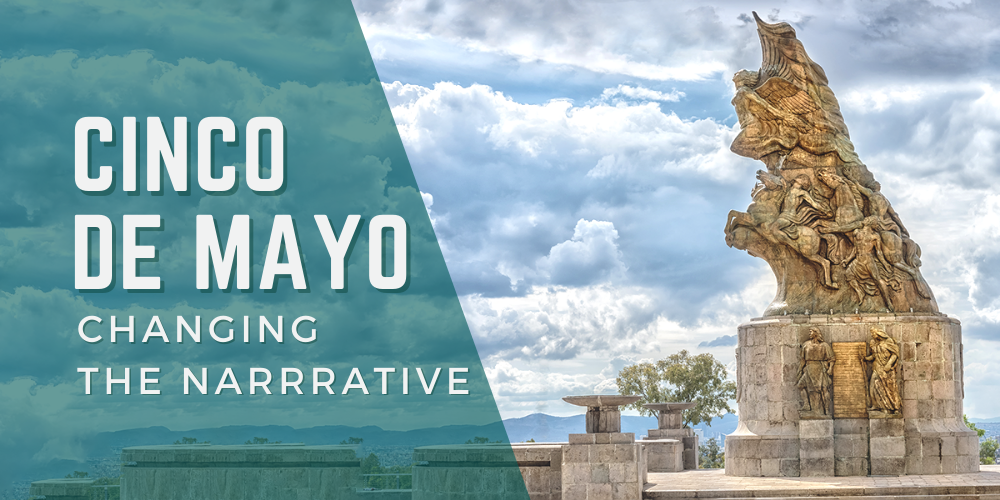Cinco de Mayo is an opportunity to celebrate Hispanic or Mexican heritage with your students. But Cinco de Mayo’s significance is often misunderstood and misrepresented, despite the importance of honoring the day with historical accuracy, an understanding of cultural appropriation, and rich stories of Hispanic and Mexican culture.
From its origins marking the Battle of Puebla to now, specific details of Cinco de Mayo’s history and heritage have morphed into a U.S. holiday celebrating tacos, kitschy sombreros, and consumption of tequila, in honor of Mexico’s Independence Day. Here’s a brief overview of the story of Cinco de Mayo:
- Cinco de Mayo is Mexico’s celebration of victory against the French in 1862 and centers on a single battle: The Battle of Puebla.
- Mexico gained independence from Spain 52 years earlier, celebrating Fiestas Patrias (Independence Day) on September 16.
- Ergo, Cinco de Mayo is not Mexico’s Independence Day.
- The holiday is to remember the heroism of the 4,000 Mexican troops in the Battle of Puebla over 8,000 French troops.
One more thing that may surprise you:
- According to Mexican history, tacos, a common street food, and Cinco de Mayo really don’t have any connection to one another.
Educators are charged with sharing and teaching about cultural heritage accurately and respectfully. How can you change the narrative to honor Mexico and Hispanic heritage on Cinco de Mayo, and avoid stereotypes and misinformation? We have gathered resources to help you!
Maria Howard of We Are Teachers offers a critical guide for teaching about Cinco de Mayo (or any other cultures in general) with 3 thoughtful and intentional questions:
- What’s my goal?
- Am I going deep enough?
- Am I treating this holiday with respect?
Once you’ve determined how you will approach the holiday, the following resources can support your planning:
- Consider connecting Cinco De Mayo’s history to resilience and the overcoming of obstacles. “Three Ways to Re-Claim Cinco de Mayo,” by Zaretta Hammond discusses how the day honors “Mexican’s push back against the would-be oppressors.”
Learning for Justice’s article, “What is Cinco De Mayo” by Lauryn Mascareñaz offers several suggestions for Cinco de Mayo-adjacent topics:
- The difference between cultural appropriation and cultural appreciation.
- The Grito de Dolores (Cry of Dolores) and how Mexico asserted its independence on September 16, 1810.
- Mexico’s ancient civilizations, including those that built enormous pyramids and used hieroglyphs to create calendars.
- In “The Real History Behind Cinco de Mayo,” Nicole Martinez-LeGrand refers to Mole Poblano, the food you should be eating to celebrate the holiday.
- Dr. Selena Kiser’s “Celebrating the Culture Around Cinco de Mayo,” highlights classroom activities for the holiday.
- SpeakingLatino.com’s “Explain the Cinco de Mayo History to Students in the United States,” includes a worksheet and video from the History Channel.
- “Rethinking Cinco de Mayo,” by Sudie Hofmann and ensure history is taught with a truthful perspective, complete with related resources connecting the holiday to current events.
- The Smithsonian article, “Did You Know? Cinco de Mayo Celebrates the Battle of Puebla?” by Erica R. Hendry summarizes the Battle of Puebla and its place in history.
- Wise words from the AP’s Maria Anglin, “Ahem, About that Sombrero,” explains why you might want to consider losing that kitschy sombrero, along with any stereotypes about people who are Hispanic.
- “5 Tips to Share Cultural Appreciation With Your Students,” by Deep space sparkle encourages us to look past commercialism to honor heritage and history.
Wow! Your Cinco de Mayo toolkit is all filled up! Please do enjoy tacos* and margaritas on Cinco de Mayo, with the knowledge that your food choice is not necessarily representative of the holiday. You have plenty of resources to connect the 5th of May to its history and why it should be celebrated. Just by reading this blog post and exploring the resources, you are part of the solution for changing the narrative around Cinco de Mayo.
*Nobody’s dissing tacos on both Tuesday and Thursday, or any other sacred time of taco consumption. I am an absolute taco advocate—anytime, anywhere. It’s just that, counter to popular beliefs, there’s no specific connection between tacos (or margaritas, or tequila) and Cinco de Mayo.







